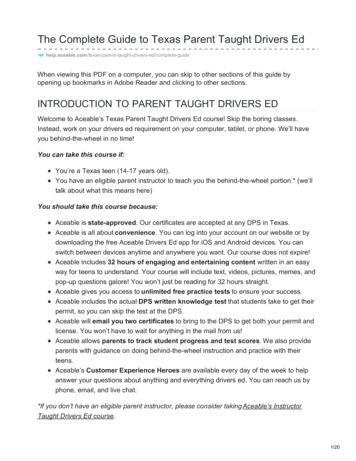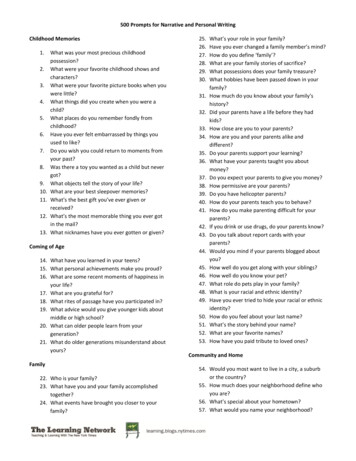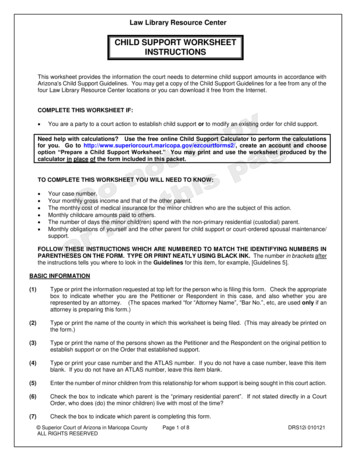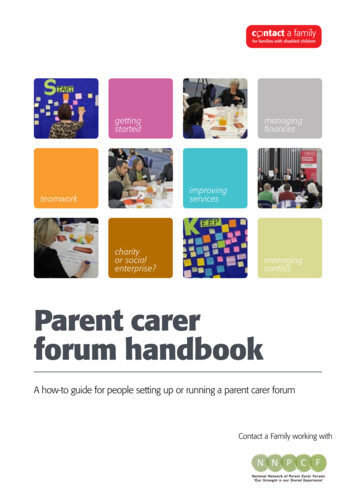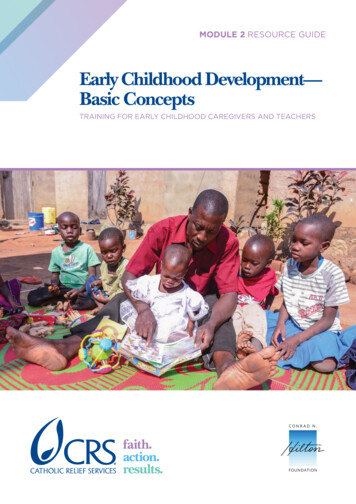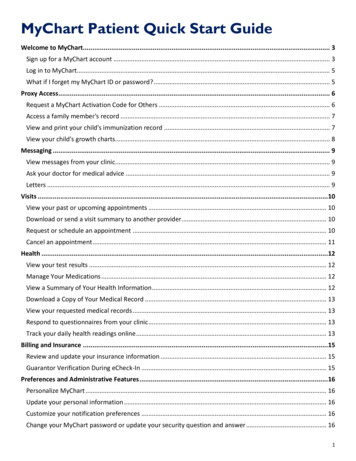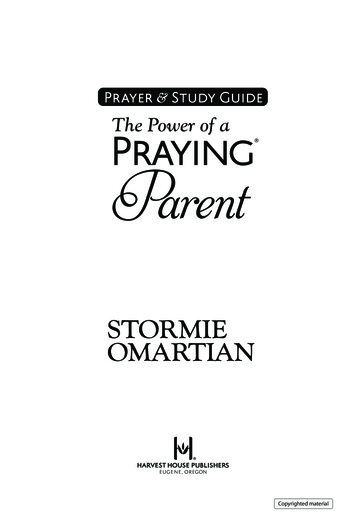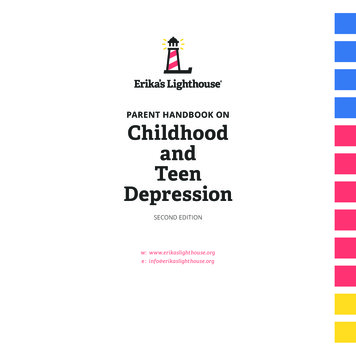
Transcription
PARENT HANDBOOK ONChildhoodandTeenDepressionSECOND EDITIONw: www.erikaslighthouse.orge : info@ erikaslighthouse.org
Parent Handbook on Childhood and Teen DepressionErika’s Lighthouse is a not-for-profit dedicated to educating and raising awarenessabout adolescent depression, encouraging good mental health and breaking downthe stigma surrounding mental health issues. For more information, please visitwww.erikaslighthouse.org.Parent Handbook on Childhood and Teen Depression SECOND EDITIONISBN: 978-1-48356-823-2 2019 Erika’s Lighthouse, Inc. All rights reserved. No part of this publication may be reproduced, stored in a retrievalsystem, or transmitted, in any form or by any means, electronic, mechanical, photocopying, recording or otherwise,without the permission of Erika’s Lighthouse, Inc. Notwithstanding the preceding, no permission is required to transmit orreproduce this publication in whole or in part for the reader’s own personal use, for other individuals who are looking forguidance regarding depression or for not-for-profit educational purposes. In fact, we encourage these uses. If you wish touse this publication for purposes other than those permitted above (such as a training seminar, conference, or meeting),please contact us for permission at info @ erikaslighthouse.org.The photography in this handbook is being used for illustrative purposes only; any person depicted in the photography isa model.This handbook is based on the experiences of parents dealing with childhood and teenage depression. It was writtenfor parents who are in similar situations. While Erika’s Lighthouse consulted with clinical, therapeutic, legal and childdevelopment experts when developing this material, it makes no representations about the medical or psychologicalopinions expressed herein, nor does it accept responsibility for any actions taken as a result of the material or informationcontained in the handbook. Every child’s and family’s situation is unique, and Erika’s Lighthouse urges parents to seek andfind competent professional advice tailored to their own family’s situation.Printed in the United States
Parent Handbook on Childhood and Teen DepressionA Few FactsAboutDepression4INTRODUCTION . . . . . . . . . . . . . . . . . . . . . . . . . . . . . . . . . . . . . . . . . . . . . . . . . . . . . . . . . . . . . . . . . . . . . . . . . . . . . . . . . . . . . . . . . . . . . . . . . . . . . 2SECTION ONE: APractical GuideCHAPTER ONE: A Few Facts About Depression.4.6CHAPTER TWO: Getting HelpWhere to BeginSECTIONONE:A PracticalGuideGetting Help6At Home26Finding the Right Help . . . . . . . . . . . . . . . . . . . . . . . . . . . . . . . . . . . . . . . . . . . . . . . . . . . . . . . . . . . . . . . . . . . . . . . . . . . . 11Getting Treatment.16CHAPTER THREE: At HomeSchool36Talking to Your Child . . . . . . . . . . . . . . . . . . . . . . . . . . . . . . . . . . . . . . . . . . . . . . . . . . . . . . . . . . . . . . . . . . . . . . . . . . . . . . 26Talking to Your Family . . . . . . . . . . . . . . . . . . . . . . . . . . . . . . . . . . . . . . . . . . . . . . . . . . . . . . . . . . . . . . . . . . . . . . . . . . . 31Taking Care of Yourself.33Definitionsand Symptoms49One Final Thought . . . . . . . . . . . . . . . . . . . . . . . . . . . . . . . . . . . . . . . . . . . . . . . . . . . . . . . . . . . . . . . . . . . . . . . . . . . . . . . . . 35CHAPTER FOUR: SchoolTalking to the School . . . . . . . . . . . . . . . . . . . . . . . . . . . . . . . . . . . . . . . . . . . . . . . . . . . . . . . . . . . . . . . . . . . . . . . . . . . . . . 36Getting Help from the School . . . . . . . . . . . . . . . . . . . . . . . . . . . . . . . . . . . . . . . . . . . . . . . . . . . . . . . . . . . . . . . . . 38Therapists57Privacy and School Records . . . . . . . . . . . . . . . . . . . . . . . . . . . . . . . . . . . . . . . . . . . . . . . . . . . . . . . . . . . . . . . . . . . 43School RefusalSECTION TWO: A.45PrimerCHAPTER ONE: Definitions and SymptomsCHAPTER TWO: Therapists.49.57CHAPTER THREE: Talk TherapyCHAPTER FOUR: Medications.61.65CHAPTER FIVE: Brain Stimulation Therapies.76.78SECTIONTWO:A PrimerTalkTherapy61Medications65CHAPTER SIX: Supplements,Mind/Body Therapies and Other TherapiesSECTION THREE: GoodBrainStimulationTherapies76Mental Health and HappinessCHAPTER ONE: Strategies for Good Mental HealthCHAPTER TWO: Happiness.81.84A Concluding Letter . . . . . . . . . . . . . . . . . . . . . . . . . . . . . . . . . . . . . . . . . . . . . . . . . . . . . . . . . . . . . . . . . . . . . . . . . . . . . . . . . . . . . . . . . .85About Erika’s Lighthouse86.Supplements,Mind/BodyTherapiesand OtherTherapies78SECTIONTHREE:Good MentalHealth andHappinessStrategiesfor GoodMentalHealth81Happiness84
Parent Handbook on Childhood and Teen DepressionWelcome to the Erika’s Lighthouse Parent Handbook on Childhood and Teen Depression,Second Edition. You may be reading our handbook because you think your child isdepressed and you want to know what to do. We are here to help you.You AreNot AloneSomewhere between 15 and 20 percent of our children and teens will suffer from atleast one depressive episode before they reach adulthood. These episodes come inmany forms—ranging from the child who doesn’t want to go to school to the teen who isconstantly in a rage to the withdrawn child who barely speaks.Often, these episodes are seen as just a phase, or typical behavior, but depression,clinical depression, is not part of typical behavior—it is a disorder that deserves attentionand needs treatment.Most children and teens who suffer from depression go undiagnosed and untreated.Many parents don’t know the signs of depression or where to turn for help, and, if theyreach out for help, they often become frustrated trying to find it. Understandingexactly what’s going on with your child, finding the right treatment, dealing with theschools—all have their unique challenges and can deplete the energy of even the mostdedicated parent.2
Parent Handbook on Childhood and Teen DepressionWe hope this handbook will be a helpful guide to you as you deal with the many issuesyou will likely confront over the course of your child’s depression. We know this isprobably a frightening time. You may feel helpless and alone. We invite you to read ourhandbook with the hope that it will give you both some comfort and some answers.And we hope you will find some helpful tips on how to help your child maintain goodmental health and find happiness, something we all want for our children.Please keep in mind—this is a parent-to-parent guide. It was written by parents, notprofessionals, and errs on the side of practical, rather than professional, advice. It is nota substitute for professional help, which we urge you to seek. And, of course, we don’thave all the solutions. We merely hope that we have at least a few suggestions that willbe of some practical help to you.Our handbook is organized into three sections.Section One is the practical guide—it will give you suggestions on what to do and howto do it. We put this section first because you may need to plunge right into ideas thatyou can put into action immediately.Section Two is a primer—it includes the things you might want to know aboutdepression, mental health care professionals and potential treatments. This is the moretextbook-like section of our handbook, and is designed to be read when you are ready toknow more about the details and the kinds of help available.Section Three is about happiness and strategies you and your child can use to fosterand maintain good mental health.Once again, our goal is to help you navigate a difficult time in your life. We hope ourhandbook will be helpful along your journey. With that in mind, we begin.
SECTION ONE :A Practical GuideA Few FactsAboutDepressionThere is a lot of stigma attached to having depression—as a society we just don’t like totalk about it. We feel guilty and ashamed—about having it, even about having it in ourfamily. But the simple fact is that depression is an identifiable and observable disorderwith specific symptoms and, like any physical illness you or your child might have,depression should be treated.Exactly what is depression?First and foremost, depression is a medical term that defines a specific disorder of thebrain. It’s more than just a sad or depressed mood, which all of us feel from time to time.Depression, called Major Depression or Major Depressive Disorder by mental healthprofessionals, is a sustained depressed mood, feeling of sadness, loss of interest orpleasure in most activities, sense of worthlessness and/or guilt, and difficulty withconcentration, thinking and making decisions.Some people with depression, especially teens, feel irritable as well. Cognitive symptoms(a drop in grades or difficulty paying attention or making decisions) often appear first.Frequently, and especially in children and teenagers, these psychological symptomsare accompanied by physical symptoms which can include agitation, fatigue, changesin sleeping patterns, appetite and/or weight, slowed speech and movement, headache,stomach-ache and other aches and pains.Some depressions are mild and one can function somewhat normally. Some are severe,limiting even the most routine daily activities or leading to thoughts of death or attemptsat suicide.4
SECTION ONE :A Practical GuideONEA Few FactsAboutDepressionMost depressions last for seven to nine months,though some last longer than that.Those who suffer from an episode of depressionare at a higher risk of having other, usually moresevere, episodes during their lifetime. Early onset,such as childhood or adolescence, is often a signthat an episode will recur.The use of alcohol can increase the risk ofdepression.Roughly two-thirds of children and teenagerswith depression have another mental disorder.Dysthymia (see Section Two), anxiety disorders,conduct disorder, substance-related disorders, ADHD (attention deficit-hyperactivitydisorder) and learning disorders are the most common co-occurring disorders.Our mothers told us to get a good night’ssleep, eat healthily and get plenty ofexercise and sun—and they were right.These common-sense ideas can helpreduce the symptoms of depression.Research also confirms the benefitsof relaxation techniques such asmeditation and breathing exercises.Somewhere between 15 and 20% of our youth will suffer from atleast one depressive episode before they reach adulthood, andteens suffer from higher rates of depression than do children.That’s too many of our young people suffering, and, as we notedbefore, most go undiagnosed and untreated.There is good research evidence that we can relieve thesymptoms of depressive episodes through treatment—talktherapy, and if that is not effective or the symptoms are severe,talk therapy and medication together.We discuss depression in more detail in Section Two, but we wanted at least to set thestage for why you should consider having your child assessed and treated if you think heis suffering from depression. And so we move on to just that subject—getting help.READING OUR HANDBOOK. For ease of reading, we use “he” to refer to your child and “she” to refer to doctors,therapists, teachers, etc. Please indulge us with this convention as you read.
SECTION ONE :A Practical GuideWhere to BeginIt’s normal for parents who think their child is suffering from depression to wonderwhether they should just wait and see or whether they should seek help.The symptoms of depression (page 4) are often evident, but sometimes they can bevague and confusing. Both children and their parents often ask themselves: is thisdepression or just a phase? Sometimes children and teens hide their feelings from theirparents and even from themselves.If you think something is amiss, trust your instinct. If you are unsure, ask a close friendor family member their opinion. The bottom line is, don’t hesitate. It’s better to err onthe side of caution than to wait—and possibly watch your child become increasinglydepressed. Increasingly severe depression can be serious.Your first phone call should be to your child’s physician. Why? Family physicians seethousands of children over their years of practice and are good at determining whetheror not there is an issue that needs treatment.The physician should ask to see your child for a physicalexamination and to run some tests to make sure that nothingelse is wrong; some illnesses, like diabetes, thyroid disease andadrenal gland disease, can act like depression and need to beruled out.Not all physicians are trained to look for mood disorders likedepression, so before you visit the doctor, take some time to jotdown your concerns—moods, behaviors and physical symptomsyou are seeing in your child:[ ] I think there is a problem because.[ ] I heard my child say.[ ] I saw my child do.[ ] My child is feeling.[ ] This is not my child’s normal behavior because.[ ] I’ve seen this change in my child over the pastweeks or6Is this an emergency? If your child isin imminent danger of hurting himselfor another person, is hearing voices,or is seeing things that aren’t there, hemay need an immediate evaluation ata hospital.Either go directly to your hospital orcall 9-1-1 for help. Call your child’sphysician and/or therapist on the wayto the hospital to tell her what’s goingon and get her advice.months.
SECTION ONE :Keep a journal. Possibly the best pieceof advice we can give at the outset is tokeep a journal. You can start the journalby including the notes that you took tothe doctor, any test results from yourvisit, behaviors, moods and physicalsymptoms you are seeing at home orhearing about from school, and changesin your child’s relationships with familymembers and friends.Try to keep up with it regularly—it will bea great aid to refer to as your child goesthrough his treatment.A Practical GuideYou may also wish to talk to your child about why you are incontact with the doctor:[ ] I notice.[ ] I care about you.[ ] It’s not your fault.[ ] We will work together to find you help.[ ] You deserve to feel better.If the doctor agrees with you that there is a problem, she mayoffer to prescribe medication to see if that helps alleviate thesymptoms. While this may seem to be an easy way to proceed,it’s best to see a professional—someone who specializes inmental health—to get a formal mental health assessment. Just asthe doctor needs to rule out diseases that act like depression, sosomeone trained in the field of mental health needs to determineexactly what’s going on with your child. Proper treatmentdepends on an accurate diagnosis.What is a mental health assessment?A mental health assessment is one or a series of interviews and tests designed to give you[1] a diagnosis, and [2] a treatment plan. Often mental health assessments are reasonablysimple—one session can be sufficient to give you a working diagnosis and treatment plan.Sometimes a more complete evaluation is needed. If your child’s behavior or mood issevere, you may need a formal assessment—a battery of tests—which might include:[ ] Interviews with and questionnaires for your child, you and other family members[ ] Interviews with mental health professionals who have worked with your childand/or your family[ ] Psychological testing of your child’s emotional and cognitive functioning[ ] Neuropsychological testing of your child’s thinking and information-processingcapabilities[ ] Psycho-social assessments of your child’s interactions with others[ ] A review of school records, such as report cards[ ] An evaluation of family dynamics[ ] A medical evaluation, which could include blood tests and neurological testingof the brain (an EEG and/or MRI).FOR EASE OF READING, we use the term “therapist” in our handbook to refer to all four mental healthprofessions. In reality, this term and the term “psychotherapist” generally refer to someone who does talktherapy—a psychologist, social worker or counselor. A psychiatrist is referred to simply as a psychiatrist.TWOGetting Help
SECTION ONE :A Practical GuideHow do you find someone to do the assessment?Mental health assessments are done by people who specialize inmental health—psychiatrists, psychologists, social workers andcounselors. The mental health field is generally one of individualpractitioners or small groups of professionals working together,so, like finding physicians, most people find someone to do anassessment by asking people they know—friends, neighbors,other parents, school personnel and members of the clergy—for referrals.Your child’s physician is probably the easiest way to find atherapist to do an assessment for your child. She also maybe able to help you get an appointment—practices are oftenbooked well in advance and it can be very helpful to havesomeone open a door for you.In addition to getting referrals from your child’s physician, schoolor people you know, you can call a local mental health socialservice agency, hospital or clinic. Many of these institutionsperform assessments, often at reduced rates.The Internet can also be of help. Many mental healthprofessional organizations have options on their websites tohelp you find a therapist in your area. Here are some that maybe helpful:[ ] The American Academy of Child and Adolescent Psychiatry(www.aacap.org)[ ] American Mental Health Counselors Association(www.amhca.org)[ ] The American Psychological Association (www.apa.org)[ ] The Depression and Bipolar Support Alliance(www.dbsalliance.org)[ ] Good Therapy (www.goodtherapy.org)[ ] The National Association of Social Workers(www.socialworkers.org)[ ] The National Board for Certified Counselors (www.nbcc.org)[ ] Psych Central (www.psychcentral.com)[ ] Psychology Today (www.psychologytoday.com)[ ] SAMHSA’s Behavioral Treatment Finder (www.samhsa.gov)8Psychiatrists and psychologists generallyhave more formal training in assessmentthan social workers and counselors—ifyour child has a complicated or severeillness, you may want to have theassessment done by one of these twoprofessionals.Taking the extra step to get anassessment may seem unnecessary—you may, understandably, want toget your child directly into therapy.But, taking the time up front to get anassessment may pay off in the long run.If, however, you are waiting for anassessment and your child is gettingworse, it might be best to get yourchild into therapy immediately (seethe next section) and come back to theassessment later if the treatment is notworking or if you believe the diagnosisyou received is not correct.You will see all sorts of therapists andtempting programs on the Internet. Aswith all information on the Internet,it’s best to check references beforeembracing a particular therapist orprogram.A good use of the Internet is to usetrusted websites to compile apreliminary list of potential therapists,and then cull that list using personalreferences you have received fromfriends, neighbors, educators and otherprofessionals in your community.
SECTION ONE :A Practical GuideWhichever source you use, it’s important to find someone to do the assessment whohas seen a wide variety of cases, who has a broad depth of experience at diagnosingmental disorders, and who has experience working with children who are similar in ageto your child.A few things to note about assessmentsDepression and similar disorders are not always easy to diagnose. It’s sometimesdifficult to tell which disorder is present, and it can often take several sessions to make acorrect diagnosis. As we noted before, many children and teenagers with depression alsosuffer from another mental disorder.Cognitive symptoms (a drop in grades, difficulty paying attention or makingdecisions) are often the first symptoms to appear. This may be why depression issometimes misdiagnosed as a learning disability.Some disorders can look like depression, but they are not. A good example of this isbipolar disorder. It’s very similar to depression until a manic (overly excited or euphoricstate) cycle sets in, but it may be several sessions before the manic cycle presents itselfto the therapist so that she can accurately identify it.Diagnosing children is tricky. Children and teenagers—especially children—are oftenunable to verbalize their feelings—they may not be at a developmental stage that allowsthem to recognize their feelings and put them into words. Also, children and teenagersare growing rapidly, both physically and mentally. Their moods and behaviors—themanifestations of the disorder—may change along with their growth. Furthermore,some behavior is appropriate at one age, and not another (think temper tantrums)—butchildren and teenagers can vary greatly from the norm in their developmental stages.A good diagnostician should consider all of these factors. She should look at whether thesymptoms are occurring with unusual frequency, lasting for an abnormal length of time,or occurring at an unexpected time during your child’s development. Taking all of thesefactors into account during the assessment is important because the treatment plan willdepend on them.TWOGetting Help
SECTION ONE :A Practical GuideCompleting the assessmentWhen your child has completed his assessment, it’s a good ideato meet with the therapist to discuss the diagnosis and talkabout treatment. If there is a report, get a copy of it and read it. Itshould include both a diagnosis and treatment plan. Write downquestions that you have. Here are some to think about:[ ] How did you arrive at the diagnosis? How certain are youof it?[ ] Can you tell me about the disorder? What are itssymptoms? What is its usual course? Where can I get moreinformation about it?[ ] Can you tell me about the treatment plan you propose?How does it work? Is this the usual treatment plan forthis illness (if not, why did you choose it)? What are thebenefits? What are the risks? Are there alternatives? Howmuch time is usually involved in treatment? Is it supportedby research? Where can I get more information about thetreatment plan and the current research on it?Involve your child. Ask him toattend the meeting with you. Often,children go through testing, butaren’t told what the results of thetests are. If you include your child inthe process, he will be better ableto understand that it’s not “him”—that it’s the disorder making himfeel the way he does. This can be animportant step towards him learningto take ownership of and managehis depression.In the end, if you don’t feel comfortable with the diagnosis, or are unsure about thetreatment plan, talk to the therapist, (and perhaps your child’s physician) about yourconcerns. Or ask for the records and get a second opinion.After your meeting, you are ready to continue to the next step—finding the right help foryour child.10
SECTION ONE :A Practical GuideFinding the Right HelpThere are three treatment options for depression—talk therapy (psychotherapy), medication or acombination of the two. Different kinds of mentalhealth professionals specialize in these differenttreatments. Psychiatrists prescribe and monitor medication.Many psychiatrists only prescribe and monitormedication; they do not practice talk therapy—but some do both. Psychologists, social workers and counselorspractice talk therapy, and often specialize in oneparticular type of therapy. They are notphysicians and therefore they cannot prescribeor monitor medication.The term “psychotherapist” or“therapist” is not a legal term; rather it’sa term we apply broadly to someonewho does psychotherapy. Psychiatrists,psychologists, social workers andcounselors have specific education,training and state licensing in theirfields—it’s best to make sure your child’stherapist is one of these professionals.Since different kinds of therapists do different things, it can beconfusing to find the right person to help your child. To add tothe confusion, the mental health community is fragmented—most therapists have private practices, which sometimes makesfinding them difficult.Most states have an on-line option tocheck whether your therapist is licensed.The treatment plan should tell you what kind of therapist yourchild needs—it’s a good starting point to begin to assemble a listof people who may be right for your child.So, given all of this, how do you find the right person?We have more information about the different kinds of therapists and therapies in SECTION TWO.TWOGetting Help
SECTION ONE :A Practical GuideAs with the assessment process, you will probably find yourchild’s therapist through referrals. You can begin by asking yourchild’s physician for her recommendations—and once againperhaps she can make a phone call to open the door for you.The person who did the initial assessment may have somenames too—in fact, she may become your child’s therapist,certainly a convenient option if the personality fit is right.Networking in your community is also a good way to find namesof therapists, and can be an especially good way to find outwhich therapists are well regarded, and which are not. In fact,parents who have been through similar circumstances maybe your best sources.Schools frequently make referrals and can be an excellentsource of names. Local mental health social service agencies,hospitals and clinics can be a good source too. Hospitals can beparticularly useful if your child suffers from disorders like eatingdisorders.Some children may be sufficientlydebilitated to require specialtreatment—hospitalization, a dayprogram they attend instead of school,or a residential therapeutic setting.If your child’s pediatrician, therapistor school recommends any of thesealternatives, or if you choose to seek anyof these because of your concern aboutyour child, you can begin by talking tothese professionals to help you makethe right decision for your child.You can also contact the NationalAssociation of Therapeutic Schoolsand Programs (www.natsap.org) tofind a therapeutic school, or hire aneducational consultant who specializesin therapeutic schools. The IndependentEducational Consultant Association(www.iecaonline.com) is a resource tohelp you find a consultant in your area.If your child needs to see more than one therapist—both a psychiatrist to prescribemedication and a talk therapist—finding one may help you find the other.Psychiatrists and talk therapists work regularly with one another and may have a goodrecommendation for the other half of the team.12
SECTION ONE :At this point, you may be wonderingabout treatment. Is it safe? Is iteffective? There is a lot of controversytoday about these two questions.Mental disorders, by their very nature,are difficult to study and thereforedifferent studies have reached differentconclusions over the years.Most mental health professionals, andthe American Psychological Association,in its 2006 Report of the WorkingGroup on Psychotropic Medications forChildren and Adolescents, recommenda conservative approach for treatingchildren and teenagers who havedepression—psychotherapy first, withregular monitoring, followed by carefullycontrolled medication (usually one ofthe SSRI antidepressants) together withthe psychotherapy if the psychotherapyalone is not effective.If, however, your child is havingsignificant difficulty with dailyfunctioning, has particularly peculiarthinking or behavior, is focused ondeath, has attempted suicide, or isengaging in self-injury like cutting, itmay be best to begin with medicationand psychotherapy together.If the situation is extremely dire—if your child is an immediate threat tohimself or others or if he is hearingvoices or seeing things that aren’tthere, you may need to considerhospitalization.A Practical GuideAs we mentioned before, the Internet can also be of help. Seepage 8 for a list of websites that may be helpful.A list of five to ten names should be sufficient to get you startedwith the process of finding the right therapist for your child. Whyso many? Often therapists are not currently taking new patients(though if you call back in a week or two, their practice may beopen) and some therapists, though a good fit for one child, maynot be the right person for your child. If a therapist is not takingnew patients, ask her for a recommendation.Interviewing therapistsOnce you have compiled your list, call each person to seewhether she is available and willing to treat your child andwhether you think she would be a good therapist for your child.You might have to call a few times; many therapists do theirown scheduling and are hard to reach. If you think the person ispotentially a good fitfor your child, set upan interview with her.You will probably wantto limit the number oftherapists you interviewto three or four—this will probably besufficient for you to findsomeone who will workwell with your child.TWOGetting Help
SECTION ONE :A Practical GuideAt the interview, tell the therapist about your child—age, gender,the reasons (i.e., the moods, behaviors and physical symptoms)that led you to seek help, and the results of your child’s mentalhealth assessment
many forms—ranging from the child who doesn’t want to go to school to the teen who is constantly in a rage to the withdrawn child who barely speaks. Often, these episodes are seen as just a phase, or typical behavior, but depression, clinical depression, is not part of
